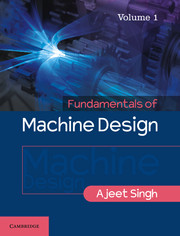19 - Shafts and Keys
Published online by Cambridge University Press: 17 July 2025
Summary
Introduction
A shaft is a cylindrical rotating machine member and is used to transmit power by torsion. Power is given to the shaft by a flange, or rotor mounted on it in the form of a pulley, a sprocket driven by a chain or gear, etc. The rotor is mounted on the shaft, fixing a key between the keyways cut or splines on the shaft and the rotor. The power may be transmitted to the same shaft from one side to another using a coupling, or from one shaft to another shaft by using belts and pulleys or chain and sprockets or a pair of gears. Shafts of small diameter are solid, but to make them light, shafts of large diameter are made hollow also. A rod is also circular, but it does not transmit torque and generally takes tensile loads.
Types of Shafts
Shafts are used for many applications like slow speed or high speed, some are of short length and some may be of big length. Following are the types of shafts according to length, speed and load.
(a) Machine shafts use the rotor integral with it, for example, lay shaft in a gear box. All gears are forged integrally with the shaft itself. These are generally of small length.
(b) Line shafts are generally long and transmit power to many machines, for example, overhead shafts. These shafts also have to bear bending along with torsion due to their length.
Information
- Type
- Chapter
- Information
- Fundamentals of Machine Design , pp. 644 - 719Publisher: Cambridge University PressPrint publication year: 2017
